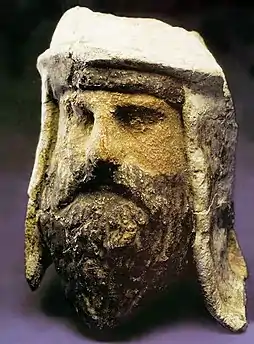Takht-i Sangin
The ancient town of Takht-i Sangin is located near the confluence of the Vakhsh and Panj rivers, the source of the Amu Darya, in southern Tajikistan.
Takht-i Sangin
Painted clay and alabaster head, Takht-i Sangin, Tajikistan, 3rd-2nd century BCE. Possibly a Zoroastrian priest.[1][2]
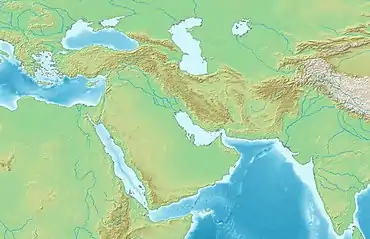
Takht-i Sangin
Location of Takht-i Sangin in Central Asia.
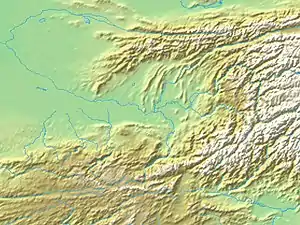
Takht-i Sangin
Takht-i Sangin (Bactria)
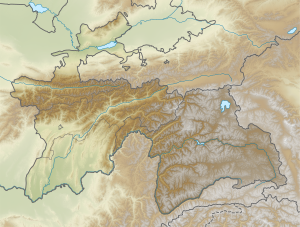
Takht-i Sangin
Takht-i Sangin (Tajikistan)
Site description
The Greco-Bactrian temple site of Takht-i Sangin is believed by many to be the source of the Oxus Treasure[3] that now resides in the Victoria and Albert Museum and British Museum. Part of greater Transoxiana and built in the 3rd Century BC, the site consists of a well-fortified citadel containing the so-called "Temple of Oxus".[4]
World Heritage Status
This site was added to the UNESCO World Heritage Tentative List on November 9, 1999 in the Cultural category.[4]
Artifacts
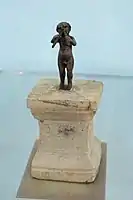 Hellenistic satyr Marsyas from Takhti Sangin, with dedication in Greek to the god of the Oxus, by "Atrosokes", a Bactrian name. 200-150 BCE. Tajikistan National Museum.[2]
Hellenistic satyr Marsyas from Takhti Sangin, with dedication in Greek to the god of the Oxus, by "Atrosokes", a Bactrian name. 200-150 BCE. Tajikistan National Museum.[2].jpg.webp) Hellenistic statuette from Takhti Sangin, 2nd century BCE, Tajikistan National Museum.[2]
Hellenistic statuette from Takhti Sangin, 2nd century BCE, Tajikistan National Museum.[2] Hellenistic statuette from Takht-i Sangin, 2nd-3rd century BCE, Tajikistan National Museum.[2]
Hellenistic statuette from Takht-i Sangin, 2nd-3rd century BCE, Tajikistan National Museum.[2] Takht-i Sangin ivory sculpture.
Takht-i Sangin ivory sculpture.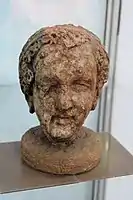 Takht-i Sangin portrait of an old man, 3rd century BCE.[2]
Takht-i Sangin portrait of an old man, 3rd century BCE.[2]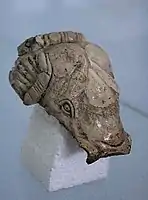 Fragment of the head of an elephant, 3rd-4th century BCE.[2]
Fragment of the head of an elephant, 3rd-4th century BCE.[2]
See also
Notes
| Wikimedia Commons has media related to Takht-i Sangin. |
- "Colorado State University".
- LITVINSKII, B. A.; PICHIKIAN, I. R. (1994). "The Hellenistic Architecture and Art of the Temple of the Oxus" (PDF). Bulletin of the Asia Institute. 8: 47–66. ISSN 0890-4464.
- Holt, F.L. (1989) p 43
- The Site of Ancient Town of Takhti-Sangin - UNESCO World Heritage Centre
References
- The Site of Ancient Town of Takhti-Sangin - UNESCO World Heritage Centre Retrieved 2009-03-04.
- Holt, F.L. (1989), Alexander the Great and Bactria: The Formation of a Greek Frontier in Central Asia: 2nd Edition, Brill Archive. ISBN 90-04-08612-9
This article is issued from Wikipedia. The text is licensed under Creative Commons - Attribution - Sharealike. Additional terms may apply for the media files.
